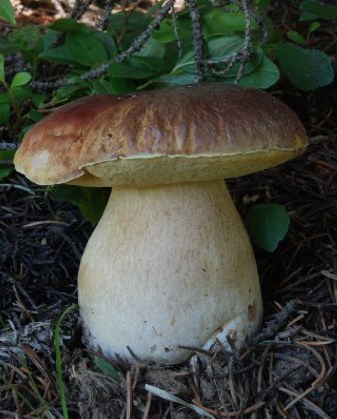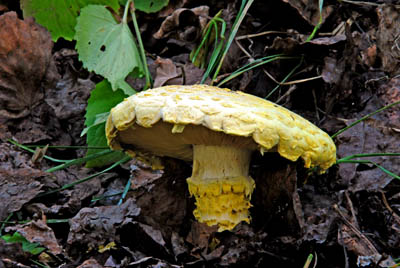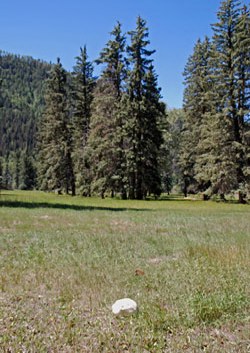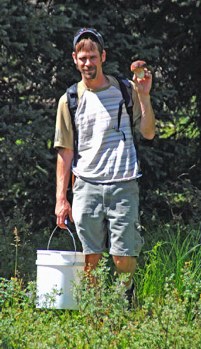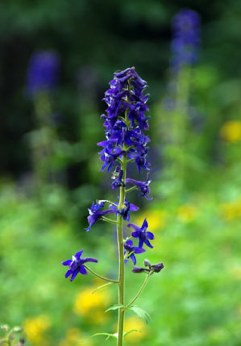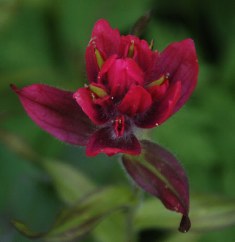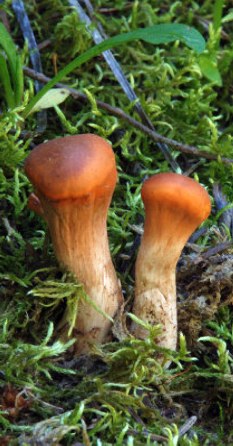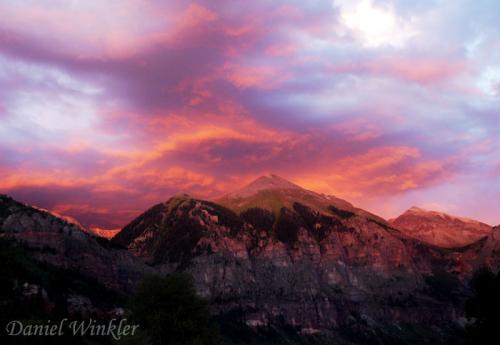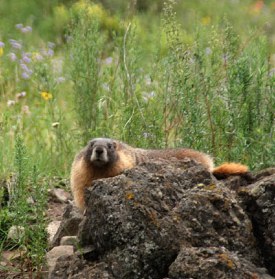Please do not rely on my descriptions and my photos for identification. In case you are not familiar with a mushroom, ask somebody who has survived his or her fungal forays and is familiar with the species you are intending to consume. A virtual misidentification can have real consequences....
August 15-19, 2014 - 33rd Telluride Mushroom Festival - Don't miss this peak event!!!
I'll be there as well, presenting on Mushrooms in Tibet!
 Telluride welcomes mushroomers for its Mushroom Festival. King Bolete - Boletus edulis 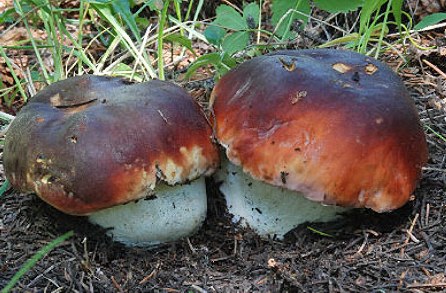 The caps of these king boletes in Colorado are nicely tanned. According to Gary Lincoff this bolete is presently best described as Boletus pinophilus 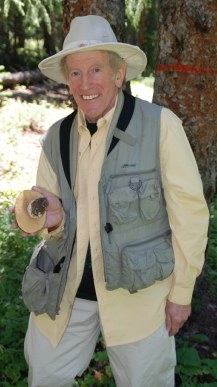 Gary Lincoff, who has been part of the mushroom festival since the beginning in 1980, is holding a king bolete. | 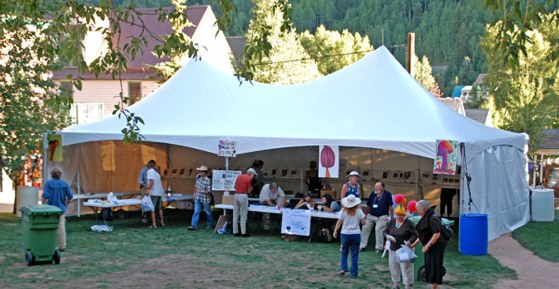 All mushroom specimen found during forays by participants are displayed in public in Telluride's Elk Park. Most specimen are identified and labeled informing about edibility, toxicity and other uses. Some might end up in the garbage can. © Daniel Winkler, August 23, 2008, Telluride, CO
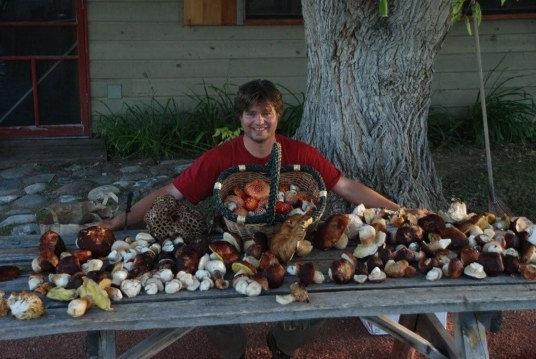 Some years are better than others! This was an afternoon of easy picking with Larry Evans in August 2010 two hours northeast of Telluride. In 2009 there were basically no boletes to be found. Partially that was caused by a dry August, which resulted in very few mushrooms in general. However, the next to complete lack of boletes made us speculated that the soil never warmed up enough to trigger fruiting. © Daniel Winkler, August 22, 2010 | ||||||
Cantharellus cibarius Golden chanterelle | |||||||
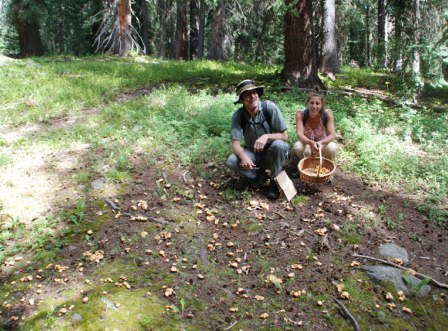 My wife Heidi and John Sir Jesse, the organizer of the festival, look in awe at the abundant congregation of American chanties (Cantharellus roseocanus). What was labeled as pre-festival forays for presenters turned out to be fungal heists in order to collect efficiently as many choice edibles as possible for the many delicious cooking events. | 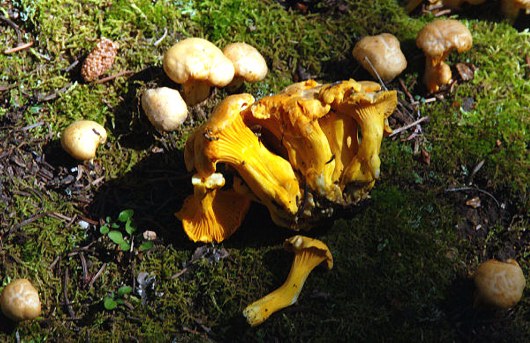 Cantharellus roseocanus are not only hiding in the woods in remote secret places, they also hide under their relatively pale caps much more intensely saturated yellow ribs and stems. | ||||||
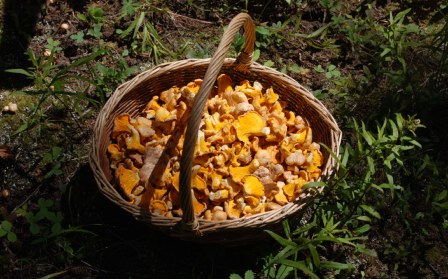 The smallish chanterelles require a quite serious "Catch per Unit Effort". The content ended up with John Sir Jesse to be fed to participants at the numerous culinary events of the mushroom festival. The smallish chanterelles require a quite serious "Catch per Unit Effort". The content ended up with John Sir Jesse to be fed to participants at the numerous culinary events of the mushroom festival. | 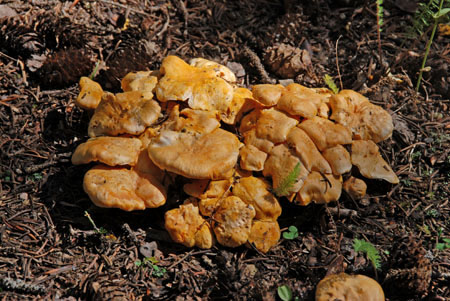 A nice cluster of chanties. © Daniel Winkler, August 20, 2008, Telluride, San Miguel County, Colorado | ||||||
Floccularia straminea var. americana Bon Scaly Yellow Floccularia | |||||||
Besides all the confusion about its human inflicted identity, this scaly, yellow, medium to large mushroom is a real beauty. And it is not just a visual delight, it is also an edible. It often grows with Quaking aspen (Populus tremuloides) and other deciduous trees, where conifers are present as well. This member of the Tricholomataceae has been referred to as Armillaria straminea (Krombh.) P. Kumm. var. americana Mitchel & A.H. Sm, and Floccularia straminea (Krombh.) Pouzar var. americana (Mitchel & A.H. Sm.) Bon, the latter being more recent. Its close European relative is named Floccularia luteovirens (Alb. ex Schw.) Pouzar. | 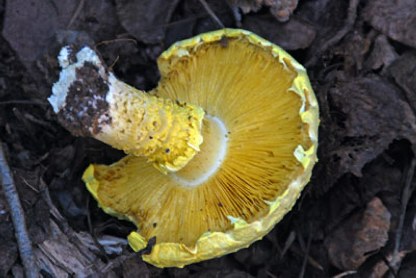 Finding this mushroom just outside of Telluride along Bear Creek trail made my day. I had not found it before in North America, but came across a very closely related mushroom in the grasslands in Tibet, where this mushroom is known as Ser sha, the "Golden Mushroom", one of Tibet's most famous mushrooms and a culinary favorite. © Daniel Winkler, August 23, 2008, Telluride, CO | ||||||
Calvatia booniana A.H. Sm. Western Giant Puffball | |||||||
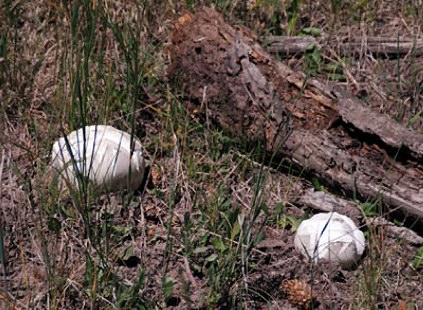 Since many years I wanted to find giant puffballs. What a sight these mushrooms are! One morning during the TMF Gary Lincoff showed us a slide from a giant puffball and mentioned that they grow around Telluride. Two hours later I am driving with festival participants to a foray in the mountains. On the way out of town, I confused my passengers by slamming my brakes out of the blue. I had scanned the landscape for big white puffs and there was something like it out there! I guess I should have a sticker on the back of my car "I brake for mushrooms" and probably another one inside for new passengers. After a bit of fence hopping I got closer to these big white things. I was really hoping that they were puffballs out there in the meadow and not white rocks or even a pair of Zippy - the Pinhead's styrofoam boots. Telluride is supposedly full of famous Californians these days.... All my life I had heard stories about this mushroom. So, I was all excited when finally cooking up the puff balls. I remembered that breading thin slices was supposed to be the best recipe. When I took my first bite and paid full attention to my taste buds, I first thought my buds must be on brake. There was hardly any taste beyond the breading crust and the fungal center offered not much of a chewing experience. I was reminded of Zippy's styrofoam boots again, not that I ever fried up styrofoam, and a marshmallow would be closer in consistency. All in all when it comes to the culinary value of the giant puff ball, I am tempted to claim just as much hype as hyphae around this mushroom. However, in all fairness, it might be a typical case of having too high expectations. Maybe I get lucky someday and someone offers me an excellent giant puffball dish? | 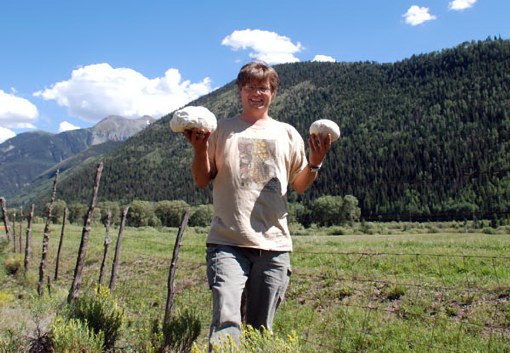
| ||||||
Russula xerampelina (Secr.) Fr Shrimp Russula | |||||||
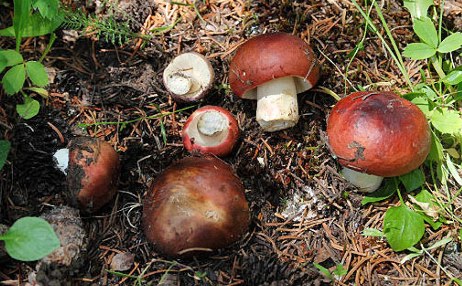 Stranded shrimps in a Engelmann spruce (Picea engelmannii) and subalpine fir (Abies lasiocarpa) forest. 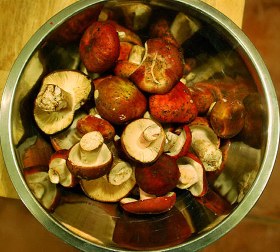 These shrimps are ready to be sliced for cooking. When cooking be prepared that its fishy odor will fill your kitchen. However, the strong smell does not necessarily translate into a strong fishy taste. Note the cream-colored gills, another feature of this "shade shifter". | 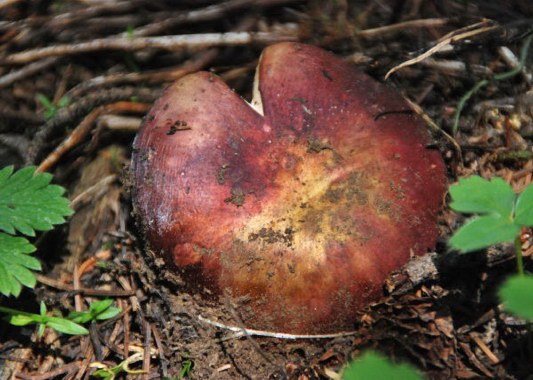 © Daniel Winkler, August 21, 2008, Telluride, CO The Shrimp Russula (Russula xerampelina) is a bit tricky to recognize, since it caps can come in many different colors, such as bright red, brownish red, maroon, deep purple, also in forms with brown caps and black centers, greenish yellow or completely honey tan, in short this mushroom is a real "shade shifter". I am showing here a common color variation. If you know how to recognize Brittle gills (Russula), luckily a genus without seriously poisonous mushrooms, you need to look for the following traits: viscid cap [when it is dry, usually some debris is glued to it], stem usually with a tinge of pink and always staining yellowish-green and then brown when handled or bruised. Its taste is mild, many other Russulas are peppery hot, and it has a fishy odor at maturity. But when this fishy odor gets a bit too strong in old specimen, it seems to smell of rotten fungus and is not very specific. "Shrimps" are quite common, but often one has to turn over quite a few Russula to find the Shrimps. The red- tinged stem, the color change and mild taste are very hard to detect without impacting the mushroom. | ||||||
Sarcodon imbricatus (L.: Fr.) P. Karst. Hawkwing 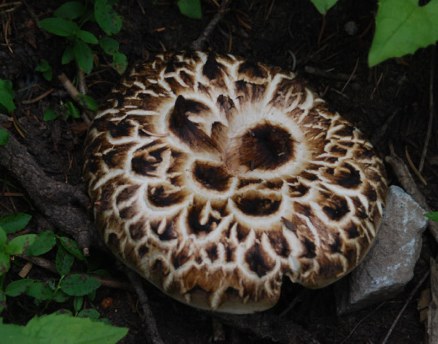 © Daniel Winkler, August 17, 2008, above Ridgeway, CO Sarcodon imbricatus, the Hawkwing is an abundant and ubiquitous fungus in conifer forests all over the northern hemisphere. When fruiting it puts out serious biomass. Unfortunately it is not too well reputed as an edible. Partially it is its unique taste, partially it is supposed to cause indigestion for some. Older specimen can be too bitter to enjoy. During the festival several dishes of the Hawkwing were served to participants and well received. Key to rendering this beautiful and easy to recognize fungi [cap with large dark brown scales, white to gray-brown teeth down below] is cooking it for at least 20 minutes to improve digestibility and reduce possible bitterness. Before eating the hawk wing in Telluride, the last dish of Sarcodon imbricatus I had many years ago in Tibet. There it is one of the most important economic mushrooms, but impresses by the tonnage collected and not the income generated due to low value [Sarcodon in Tibet]
Probably a Leccinum aurantiacum hugging a Quaking aspen (Populus tremuloides). Usually they express their fondness for each other on root level. As being displayed here, "Aspen bolete" is a well placed common name. Leccinum aurantiacum is a good edible. It turns black if you don't fry it right away after slicing. Some people react unfavorable to Leccinum, but there are more difficult members of the genus, when it comes to allergic reactions. |
Leccinum aurantiacum (Bull.) Gray Aspen bolete 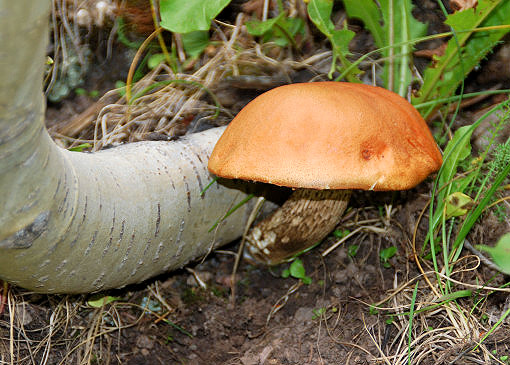 | ||||||
The Mushroom Parade - MushRoaming Telluride Main Street | |||||||
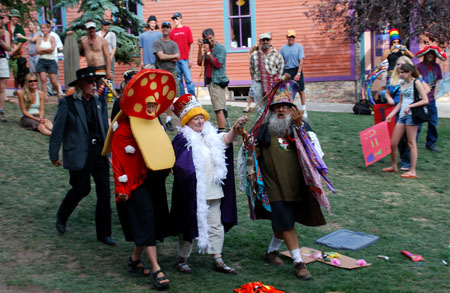 Queen Rita Amanita blesses her subjects escorted by high officials such as Art Goodtimes, one of the spirits behind the event. © Daniel Winkler, August 23, 2008, Telluride, CO | 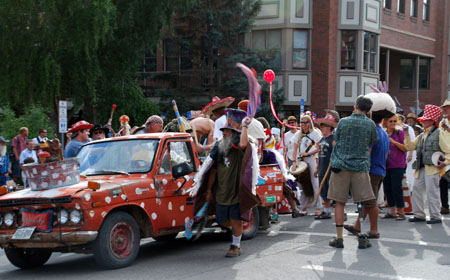 The drummers are loaded onto a bed of a pick up, which is pushed down Main Street. Each year Main Street is closed for the mushroom parade. Telluride got its priorities right! © Daniel Winkler, August 23, 2008, Telluride, CO | ||||||
The mushroom parade arrived at the town park. A drum circle moved Cordyceps, Amanitas and other fun guys.  "Pick your friends carefully" Who is Larry Evans talking about? "Pick your friends carefully" Who is Larry Evans talking about?© Daniel Winkler, August 23, 2008, Telluride, CO |
What an awesome sky, neither photoshopped nor fungally enhanced! | ||||||
| |||||||
Main sources: Gibson, Ian & Eli; Kendrick, Bryce 2008. MatchMaker- Gilled Mushrooms of the Pacific Northwest 1.31 - awesome software, free download! Lincoff, Gary 1981. The Audubon Society Field Guide to North American Mushrooms. States, Jack 1990. Mushrooms and Truffles of the Southwest. | |||||||
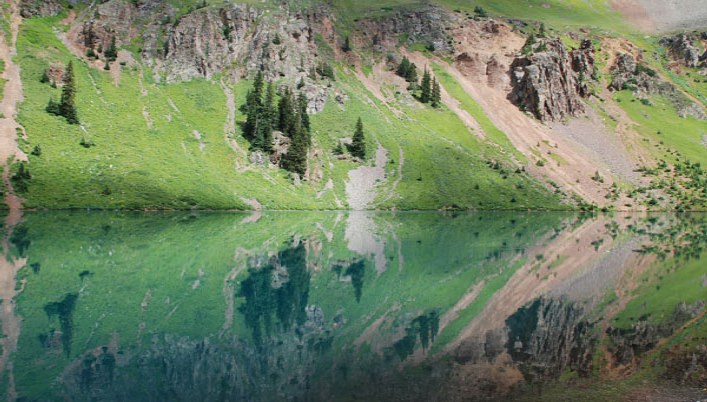 One of the Blue Lakes under Mt. Sneffels, Ouray County, Colorado © Daniel Winkler, August 18, 2008 | |||||||

